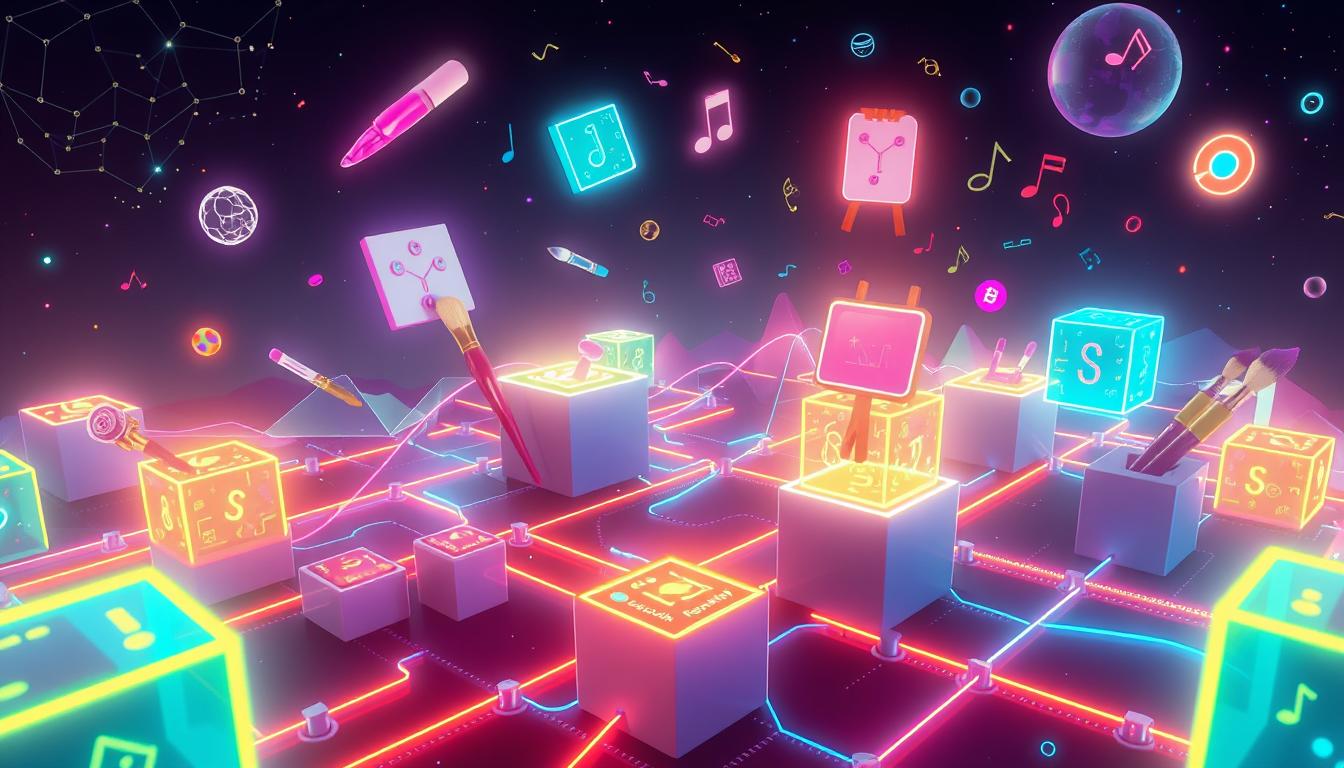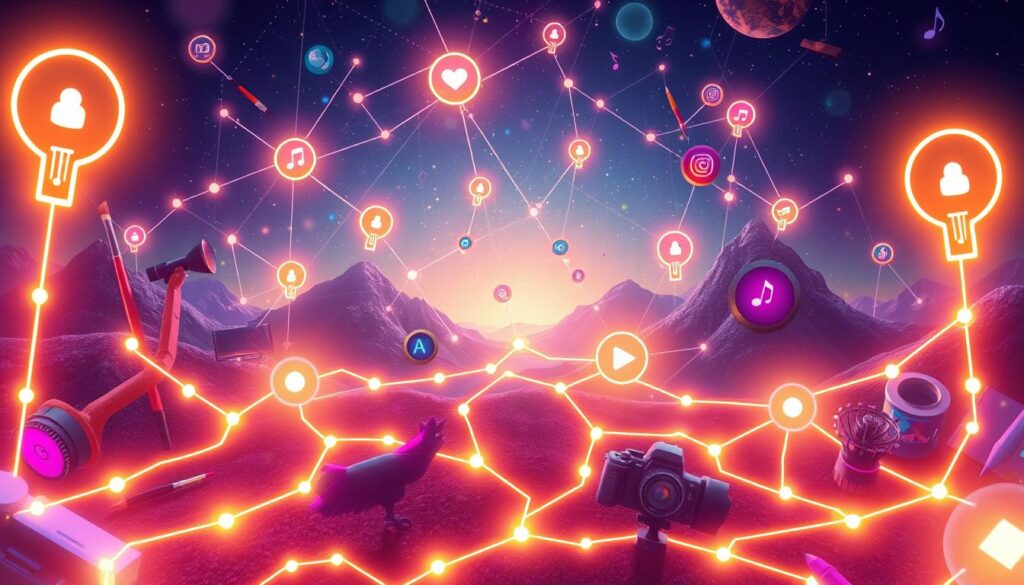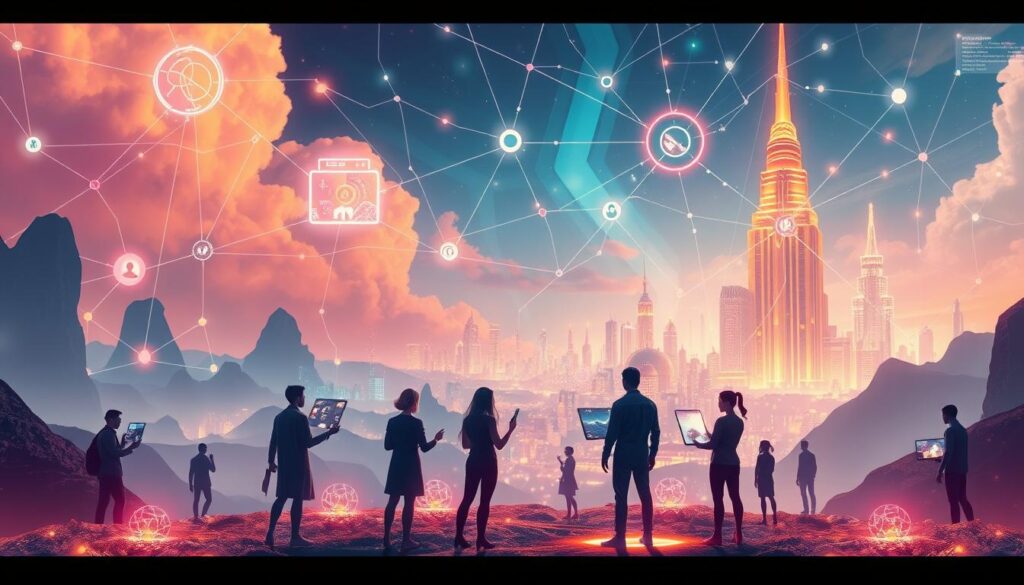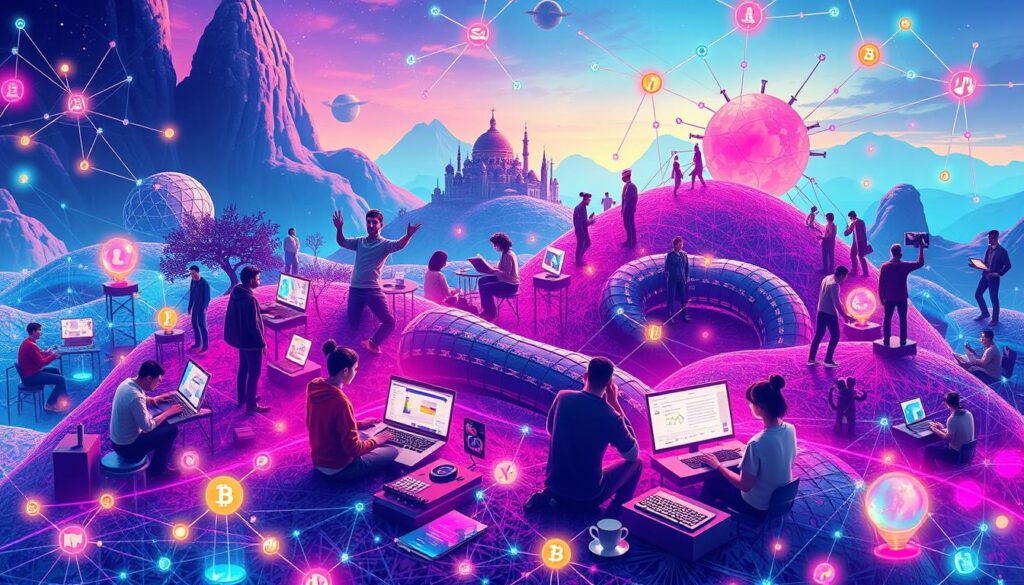Now Reading: Blockchain for Content Creators: A Creative Revolution
- 01
Blockchain for Content Creators: A Creative Revolution
Blockchain for Content Creators: A Creative Revolution

The content creation landscape is undergoing a profound transformation, and at the heart of this revolution lies blockchain technology. As creators navigate the evolving digital landscape, they are confronted with a myriad of challenges, including copyright infringement, unfair revenue distribution, and a lack of transparency in the industry. However, the advent of blockchain offers a promising solution to these longstanding issues, empowering content creators to take control of their digital assets and unlock new avenues for success.
Blockchain, the distributed ledger technology that underpins cryptocurrencies like Bitcoin, has the potential to revolutionize the way creators interact with their audiences and monetize their work. By harnessing the power of decentralization, smart contracts, and transparent record-keeping, blockchain presents a compelling alternative to the centralized platforms that have historically dominated the content creation industry.
In this article, we will explore the intersection of blockchain and the creative economy, delving into the benefits, challenges, and future implications of this transformative technology for content creators. From enhanced copyright protection and fair revenue distribution to the rise of tokenization and the power of smart contracts, we will uncover the ways in which blockchain is shaping the future of content creation.
Key Takeaways
- Blockchain technology offers a decentralized solution to address the challenges faced by content creators, such as copyright infringement and unfair revenue distribution.
- Decentralized platforms and tokenized digital assets empower creators to take control of their work and monetize their content more effectively.
- Smart contracts enable transparent and automated royalty payments, ensuring fair compensation for creators.
- The rise of the Web3 creative economy promises to revolutionize the way creators engage with their audiences and build sustainable careers.
- Successful case studies demonstrate the tangible benefits of blockchain adoption for content creators, leading to increased revenue and fan engagement.
Understanding Blockchain Technology
Blockchain technology has emerged as a transformative force in the digital world, revolutionizing the way we approach Decentralized Content Platforms and Tokenized Digital Assets. At its core, a blockchain is a distributed digital ledger that records transactions in a secure, transparent, and immutable manner.
Definition of Blockchain
A blockchain is a continuously growing list of records, called blocks, which are linked and secured using cryptography. Each block typically contains a batch of individual transactions, and every time a new transaction occurs, a record of that transaction is added to every participant’s ledger. The decentralized nature of blockchain technology ensures that the data is not controlled by a single entity, providing a high level of trust and security.
Key Features of Blockchain
- Decentralization: Blockchain networks are decentralized, meaning they are not controlled by a single authority, but rather by a network of participants.
- Immutability: Once a transaction is recorded on the blockchain, it becomes virtually impossible to alter or delete, ensuring the integrity of the data.
- Transparency: All transactions on the blockchain are visible to all participants, promoting transparency and accountability.
- Security: Blockchain technology employs advanced cryptographic techniques to secure the network and protect against unauthorized access or tampering.
How Blockchain Works
The blockchain operates on a peer-to-peer network, where each participant (node) has a copy of the entire ledger. When a new transaction occurs, it is broadcast to the network, and the nodes in the network validate the transaction using a consensus mechanism. Once validated, the transaction is added to a new block, which is then added to the existing chain of blocks, creating an unbroken record of all transactions. This decentralized and tamper-resistant nature of blockchain technology holds immense potential for a wide range of applications, including Decentralized Content Platforms and Tokenized Digital Assets.
The Rise of Content Creation
The digital age has ushered in a transformative era for content creation. From traditional media to the proliferation of user-generated content, the landscape of content production and consumption has evolved dramatically. As the demand for engaging and personalized digital experiences continues to grow, content creators have found themselves navigating a complex and ever-changing industry.
The Evolution of Content Creation
The rise of social media platforms and the ubiquity of mobile devices have empowered individuals to become content creators. Digital Content Monetization has become a viable avenue for creators to monetize their work, leading to the emergence of influencer marketing and a shift in the traditional media landscape.
Current Trends in the Content Industry
- Increased focus on Peer-to-Peer Content Sharing and community-driven platforms
- Diversification of revenue streams for content creators, including microtransactions and subscription models
- Heightened emphasis on audience engagement and the personalization of content
- Challenges in effectively monetizing user-generated content and addressing copyright concerns
As the content industry continues to evolve, the need for innovative solutions to empower creators and address the challenges of Digital Content Monetization has become increasingly apparent. Emerging technologies, such as blockchain, have the potential to disrupt the status quo and reshape the landscape of content creation and distribution.
“The rise of digital content has fundamentally changed the way audiences consume and interact with creative works. Empowering creators to own their content and monetize it effectively is crucial for the future of the industry.”
Benefits of Blockchain for Creators
Blockchain technology offers a transformative solution for content creators, empowering them with unprecedented control and transparency over their intellectual property. By leveraging the immutable and decentralized nature of blockchain, creators can now enjoy enhanced Intellectual Property Protection and fair, Transparent Royalty Distribution – two key advantages that are revolutionizing the content creation landscape.
Enhanced Copyright Protection
Blockchain-based digital assets provide an unparalleled level of copyright protection for creators. The tamper-proof nature of the blockchain ensures that the provenance and ownership of digital content can be irrefutably established, preventing unauthorized use or distribution. This empowers creators to maintain full control over their intellectual property, safeguarding their creative work from piracy and infringement.
Fair Revenue Distribution
- Blockchain-enabled smart contracts facilitate automated and transparent royalty payments, ensuring that creators receive their fair share of earnings from their work.
- By eliminating intermediaries and middlemen, blockchain eliminates the potential for unfair or opaque revenue distribution, enabling creators to directly monetize their content and connect with their audience.
- This level of transparency and fairness in the content industry can foster a more equitable ecosystem, where creators are empowered to thrive and build sustainable careers.
Increased Transparency
The decentralized nature of blockchain provides unparalleled transparency throughout the content creation and distribution process. Every transaction, from licensing agreements to royalty payments, is recorded immutably on the blockchain, allowing creators to track the performance and monetization of their work with unprecedented visibility. This enhanced transparency fosters trust and accountability within the creative ecosystem, empowering creators to make informed decisions and negotiate more favorable terms.

“Blockchain technology has the potential to revolutionize the content creation industry, offering creators the tools they need to protect their intellectual property, ensure fair compensation, and build direct relationships with their audience.”
| Benefit | Description |
|---|---|
| Intellectual Property Protection | Blockchain’s immutable ledger ensures the provenance and ownership of digital content, preventing unauthorized use or distribution. |
| Transparent Royalty Distribution | Automated smart contracts facilitate fair and transparent royalty payments, eliminating the potential for unfair revenue distribution. |
| Increased Transparency | The decentralized nature of blockchain provides creators with unprecedented visibility into the performance and monetization of their work. |
Tokenization in the Creative Industry
As the creative industry continues to evolve, the concept of tokenization has emerged as a game-changer for content creators. Tokenization, a process that transforms digital assets into unique, verifiable, and tradable blockchain-based tokens, is revolutionizing the way creators can own, manage, and monetize their work.
What is Tokenization?
Tokenization is the process of converting a digital asset, such as a piece of art, music, or video, into a unique token on a blockchain network. These tokens, known as NFT Content Ownership, provide creators with a way to establish verifiable ownership and authenticity of their digital creations. By tokenizing their work, creators can control the distribution, licensing, and resale of their Tokenized Digital Assets, ensuring they receive fair compensation for their efforts.
Types of Tokens for Creators
- Non-Fungible Tokens (NFTs): NFTs are unique, one-of-a-kind tokens that represent ownership of a specific digital asset. They allow creators to sell their work as limited editions or exclusive pieces, providing scarcity and value to their digital creations.
- Utility Tokens: Utility tokens are cryptocurrencies that can be used within a specific platform or ecosystem. Creators can use these tokens to grant access to exclusive content, offer special features, or reward their loyal fans and followers.
- Security Tokens: Security tokens represent a financial interest in an underlying asset, such as a percentage of revenue or royalties from a creator’s work. These tokens can provide creators with a new way to raise capital and share the profits with their supporters.
By embracing the power of tokenization, content creators can unlock new opportunities to monetize their work, build stronger connections with their audience, and gain greater control over the distribution and ownership of their Tokenized Digital Assets.
“Tokenization has the potential to revolutionize the creative industry, empowering creators to take charge of their digital assets and reap the full rewards of their hard work.”
Smart Contracts: A Game Changer
As the creative industry embraces the transformative power of blockchain technology, one of the most exciting developments has been the rise of smart contracts. These self-executing digital agreements have the potential to revolutionize content creation, distribution, and monetization, paving the way for a new era of Smart Contracts for Creators and Transparent Royalty Distribution.
Understanding Smart Contracts
At their core, smart contracts are automated, programmable agreements that operate on blockchain networks. They are designed to execute pre-defined actions when specific conditions are met, without the need for human intervention. In the context of the creative industry, smart contracts can automate royalty payments, enforce intellectual property rights, and ensure fair compensation for creators.
Use Cases in the Creative Landscape
- Automated Royalty Payments: Smart contracts can be programmed to automatically distribute royalties to creators, ensuring timely and transparent compensation based on pre-determined terms.
- Streamlined Content Licensing: Smart contracts can facilitate the licensing of digital content, simplifying the process and reducing the administrative burden for creators and consumers.
- Fractional Ownership: Smart contracts enable the creation of tokenized assets, allowing creators to sell fractional ownership of their work and share in the ongoing revenue stream.
- Decentralized Marketplaces: Smart contracts can power decentralized platforms for the trading of digital assets, providing creators with more control and a fairer revenue model.
| Feature | Benefit |
|---|---|
| Automated Royalty Payments | Ensures Transparent Royalty Distribution and timely compensation for creators |
| Streamlined Content Licensing | Simplifies the licensing process, reducing administrative burden for creators and consumers |
| Fractional Ownership | Allows creators to monetize their work through the sale of tokenized assets |
| Decentralized Marketplaces | Provides creators with more control and a fairer revenue model |
As the creative industry continues to evolve, the integration of smart contracts promises to be a game-changer, empowering creators with Smart Contracts for Creators and delivering Transparent Royalty Distribution in the digital age.
Platforms Utilizing Blockchain for Creators
In the evolving world of content creation, the rise of Decentralized Content Platforms has opened up new avenues for creators to thrive in the Web3 Creative Economy. These innovative platforms, built on blockchain technology, are empowering artists, writers, and other creative professionals to take control of their digital assets and monetize their work in unprecedented ways.
Overview of Notable Platforms
Several blockchain-based platforms have emerged as leaders in the Decentralized Content Platforms space, each offering unique features and benefits to creators. Some of the most notable examples include:
- Steemit, a social media platform that rewards users for creating and curating content using its native cryptocurrency, STEEM.
- Audius, a decentralized music-sharing platform that allows artists to upload, distribute, and monetize their work without the involvement of traditional music labels.
- OpenSea, a marketplace for non-fungible tokens (NFTs), enabling creators to sell their digital art, collectibles, and other unique digital assets directly to buyers.
Comparison of Features and Benefits
Each of these Decentralized Content Platforms brings something unique to the table for creators. For instance, Steemit’s rewarding system incentivizes user engagement and content curation, while Audius provides artists with greater control over the distribution and monetization of their music. OpenSea, on the other hand, has revolutionized the digital art market by enabling creators to tokenize and sell their work as NFTs.
These platforms are at the forefront of the Web3 Creative Economy, empowering creators to take advantage of blockchain technology and the decentralized nature of the internet. By offering enhanced copyright protection, fair revenue distribution, and increased transparency, they are paving the way for a more creator-centric future in the digital landscape.

Challenges Facing Blockchain Adoption
While the potential of [https://cryptomaximal.com/what-is-cryptocurrency-2/] blockchain technology in the content creation industry is undeniable, there are several challenges that hinder its widespread adoption. Content creators and digital content enthusiasts must navigate through a complex web of technical barriers and the need for increased education and awareness to fully harness the benefits of this transformative technology.
Technical Barriers
One of the primary challenges facing the adoption of blockchain for Blockchain for Content Creators is the issue of scalability. The high transaction volume and data processing requirements of the content creation industry can strain the capacity of traditional blockchain networks, leading to slow transaction times and network congestion. Additionally, the user experience of interacting with blockchain-based platforms can be complex and intimidating for many creators, deterring mainstream adoption.
Education and Awareness
Another significant hurdle is the general lack of understanding and awareness about the applications of Digital Content Monetization blockchain technology in the content creation industry. Many creators are unfamiliar with the core principles of blockchain, such as decentralization, transparency, and secure peer-to-peer transactions. Without a comprehensive understanding of the benefits and use cases, content creators may be hesitant to embrace this new technological frontier.
To overcome these challenges and drive widespread adoption, the content creation industry must invest in educational initiatives, user-friendly interfaces, and robust infrastructure development. By addressing the technical barriers and fostering a deeper understanding of blockchain’s capabilities, content creators can unlock the transformative power of this revolutionary technology and pave the way for a new era of digital content monetization.
Successful Case Studies
In the rapidly evolving landscape of the Web3 Creative Economy, content creators have embraced blockchain technology to unlock new possibilities for their craft and revenue streams. Several notable creators have pioneered the use of blockchain, showcasing the transformative potential of this innovative approach to digital content ownership and monetization.
Notable Creators Using Blockchain
One such trailblazer is Grimes, the Canadian musician and visual artist who has leveraged NFT Content Ownership to redefine the relationship between artists and their audience. By selling digital artworks and exclusive content as non-fungible tokens (NFTs), Grimes has empowered her fans to own a piece of her creative legacy, fostering a deeper connection and sense of community.
Similarly, the best-selling author Ernest Cline has explored the potential of blockchain in the literary world. His novel “Ready Player Two” incorporated NFT-based digital collectibles, allowing readers to own a unique piece of the story and engage with the narrative in a more immersive manner.
Impact on Revenue and Engagement
| Creator | Revenue Increase | Engagement Boost |
|---|---|---|
| Grimes | Over $6 million from NFT sales | Deepened fan connections and community |
| Ernest Cline | Significant revenue from NFT book collectibles | Enhanced reader interactivity and loyalty |
These successful case studies demonstrate how NFT Content Ownership and blockchain-based platforms can empower content creators to monetize their work in innovative ways, while also fostering deeper engagement with their audiences. As the Web3 Creative Economy continues to evolve, more creators are likely to embrace these transformative technologies, paving the way for a new era of creative expression and empowerment.
“Blockchain has the potential to revolutionize the way we create, distribute, and consume content. The opportunities for content creators are endless.”
The Future of Content Creation with Blockchain
As the Blockchain for Content Creators revolution continues to unfold, the future of the Web3 Creative Economy is rife with exciting possibilities. Content creators can look forward to a decade of transformative innovations that will reshape the way they create, distribute, and monetize their work.
Predictions for the Next Decade
In the coming years, we can expect to see blockchain technology become even more integrated into the daily workflows of content creators. Decentralized platforms will empower creators to retain greater control over their intellectual property and revenue streams, reducing the influence of centralized intermediaries. The rise of non-fungible tokens (NFTs) will further revolutionize the way digital content is valued, traded, and authenticated.
Potential Innovations to Watch
- Seamless cross-platform content monetization through blockchain-based micropayments
- Decentralized digital marketplaces that enable direct creator-to-fan transactions
- Automated royalty distribution systems powered by smart contracts
- Collaborative content creation and co-ownership models facilitated by blockchain
- Innovative content financing models, such as crowdfunding and fan-backed projects
As the Blockchain for Content Creators ecosystem continues to evolve, content creators can look forward to a future where they have greater autonomy, transparency, and earning potential. By embracing the transformative power of blockchain, the Web3 Creative Economy is poised to redefine the way creators and audiences engage with one another, ushering in a new era of creativity and collaboration.

“The future of content creation lies in the seamless integration of blockchain technology, empowering creators to truly own and control their digital assets.”
Community Building Through Blockchain
In the evolving landscape of content creation, blockchain technology offers a transformative approach to fostering vibrant communities. By leveraging the power of decentralized networks, creators can now build direct, meaningful connections with their audiences, paving the way for a more collaborative and rewarding creative ecosystem.
Utilizing Decentralized Networks
Blockchain-powered platforms enable creators to engage with their fans in a decentralized manner, breaking down the barriers that traditionally existed between content creators and their communities. These decentralized networks facilitate Peer-to-Peer Content Sharing, allowing for seamless and transparent sharing of digital content, while ensuring creators maintain control over their intellectual property.
Engaging Fans with Cryptocurrencies
The integration of cryptocurrencies and Tokenized Digital Assets within the creative landscape empowers creators to forge deeper connections with their fans. Fans can directly support their favorite creators by purchasing digital goods, exclusive content, or even fractional ownership of creative works, fostering a sense of community and shared investment in the success of the creator.
By harnessing the power of blockchain, creators can cultivate more authentic and engaged communities, where fans feel a genuine sense of ownership and investment in the creative process. This shift towards decentralized, transparent, and fan-centric models has the potential to revolutionize the way content is created, distributed, and consumed.
“Blockchain technology is the key to unlocking a new era of community-driven content creation, where creators and their audiences work hand-in-hand to shape the future of the creative industry.”
As the adoption of blockchain in the creative industry continues to grow, the opportunities for community building and fan engagement will only expand, paving the way for a more vibrant and collaborative future for content creators.
Legal Implications of Blockchain for Creators
As the blockchain revolution sweeps through the creative industry, content creators must navigate the complex legal landscape that comes with this transformative technology. Two key areas of concern are Intellectual Property Protection and the regulatory challenges posed by blockchain-based platforms.
Copyright and Ownership Issues
Blockchain technology offers new ways to protect intellectual property rights. Smart Contracts for Creators can help creators establish clear ownership and distribution rights, ensuring fair compensation. However, the decentralized nature of blockchain raises questions about traditional copyright laws and their application in this new digital ecosystem.
- Establishing provenance and authenticity of digital assets on the blockchain
- Determining ownership and licensing rights in a distributed network
- Ensuring creators maintain control over their work in the face of unauthorized distribution
Regulatory Challenges
The rapid evolution of blockchain-based platforms has outpaced the regulatory environment, leaving creators and platforms in a state of uncertainty. Navigating the complex web of national and international laws is crucial for creators to protect their interests and ensure compliance.
- Adapting existing legal frameworks to accommodate blockchain-based business models
- Addressing issues of data privacy, security, and consumer protection
- Clarifying the legal status of cryptocurrencies and digital assets
As the adoption of blockchain in the creative industry continues to grow, content creators must stay informed and proactive in addressing the legal implications. By understanding the nuances of Intellectual Property Protection and the evolving regulatory landscape, creators can harness the power of blockchain to protect their rights and thrive in the digital age.
How to Get Started with Blockchain
As a content creator, the prospect of leveraging blockchain technology may seem daunting, but the rewards can be substantial. The first step is to familiarize yourself with the fundamentals of blockchain and its potential applications in the creative industry. This can involve exploring educational resources, attending relevant workshops, or seeking guidance from industry experts.
Steps for Content Creators
Creators interested in incorporating blockchain into their workflows should consider the following steps: Research blockchain-based platforms that cater to the needs of content creators, such as Opensea, Rarible, or SuperRare. Understand the process of minting and selling non-fungible tokens (NFTs) to monetize your digital creations. Explore the benefits of Smart Contracts, which can automate royalty payments and streamline rights management. Engage with the blockchain community by participating in online forums, social media groups, or attending virtual events to stay up-to-date with the latest trends and best practices.
Resources and Tools Available
The blockchain ecosystem offers a growing array of resources and tools to assist content creators in their journey. Online learning platforms like Coursera and Udemy provide comprehensive courses on blockchain fundamentals and its applications in the creative industry. Industry publications, such as Decrypt and CoinDesk, offer valuable insights and news related to the intersection of blockchain and content creation. Additionally, various blockchain-based platforms provide user-friendly interfaces and educational materials to help creators navigate the process of minting, selling, and managing their NFTs.
FAQ
What is blockchain technology and how can it benefit content creators?
Blockchain is a decentralized, transparent, and secure digital ledger that can revolutionize the content creation industry. By empowering creators with features like enhanced copyright protection, fair revenue distribution, and increased transparency, blockchain technology can address many of the challenges faced by today’s content creators.
How can tokenization and NFTs transform content ownership and monetization?
Tokenization, including the use of Non-Fungible Tokens (NFTs), allows creators to establish unique digital ownership and monetize their content in new ways. NFTs can represent various types of digital assets, enabling creators to sell their work as scarce, verifiable digital items and earn royalties on secondary sales.
What are the benefits of using smart contracts for content creators?
Smart contracts, which are self-executing digital agreements, can automate and streamline various aspects of the content creation and distribution process. They can ensure transparent and fair royalty payments, protect intellectual property rights, and facilitate direct transactions between creators and their audience.
What are some notable blockchain-based platforms designed for content creators?
There are several blockchain-based platforms that cater to content creators, including Steemit, Audius, and OpenSea. These platforms offer decentralized content distribution, monetization opportunities, and community-driven engagement, empowering creators to take control of their digital assets and revenue streams.
What are the challenges in adopting blockchain technology for content creation?
While blockchain offers numerous benefits, there are also challenges that hinder widespread adoption, such as technical barriers (e.g., scalability, user experience), education and awareness gaps among creators and consumers, and regulatory uncertainties. Overcoming these challenges will be crucial for the successful integration of blockchain in the creative economy.
How can content creators get started with blockchain technology?
To get started with blockchain for content creation, creators can explore blockchain-based platforms, learn about creating and selling NFTs, and utilize available resources and tools. This includes understanding the technical aspects, legal implications, and best practices for leveraging blockchain technology to enhance their creative endeavors and thrive in the Web3 creative economy.














